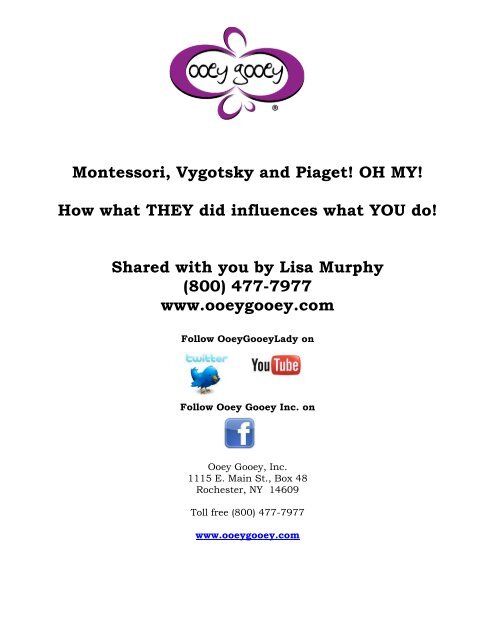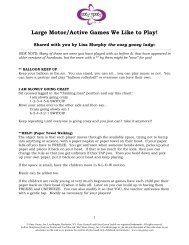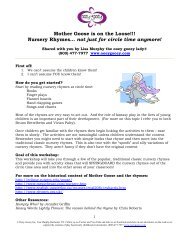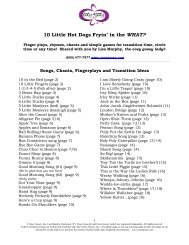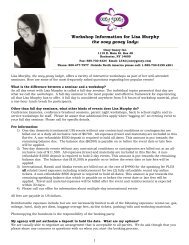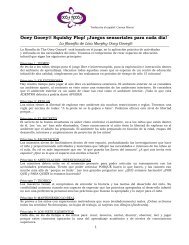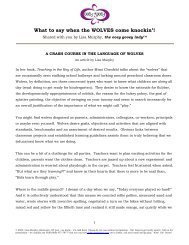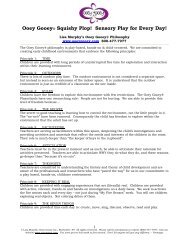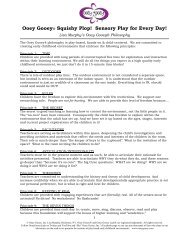Montessori, Vygotsky and Piaget! OH MY! How ... - Ooey Gooey, Inc.
Montessori, Vygotsky and Piaget! OH MY! How ... - Ooey Gooey, Inc.
Montessori, Vygotsky and Piaget! OH MY! How ... - Ooey Gooey, Inc.
Create successful ePaper yourself
Turn your PDF publications into a flip-book with our unique Google optimized e-Paper software.
<strong>Montessori</strong>, <strong>Vygotsky</strong> <strong>and</strong> <strong>Piaget</strong>! <strong>OH</strong> <strong>MY</strong>!<br />
<strong>How</strong> what THEY did influences what YOU do!<br />
Shared with you by Lisa Murphy<br />
(800) 477-7977<br />
www.ooeygooey.com<br />
Follow <strong>Ooey</strong><strong>Gooey</strong>Lady on<br />
Follow <strong>Ooey</strong> <strong>Gooey</strong> <strong>Inc</strong>. on<br />
<strong>Ooey</strong> <strong>Gooey</strong>, <strong>Inc</strong>.<br />
1115 E. Main St., Box 48<br />
Rochester, NY 14609<br />
Toll free (800) 477-7977<br />
www.ooeygooey.com
Table of Contents<br />
There are lots of “masters” in the field of early education.<br />
Here are the ones we are looking at today:<br />
Fredrich Froebel……………………………….. 2<br />
Maria <strong>Montessori</strong>………………………………. 4<br />
Lev <strong>Vygotsky</strong>……………………………………. 5<br />
Rudolph Steiner (Waldorf)…………………… 7<br />
Reggio Emilia……………………………………. 8<br />
Jean <strong>Piaget</strong>………………………………………. 9<br />
John Dewey……………………………………… 10<br />
Constructivism………………………………… 11<br />
1<br />
Shared with you by Lisa Murphy www.ooeygooey.com (800) 477-7977
Meet A Master<br />
Friedrich Froebel 1782-1852 (70)<br />
• Lived in Germany<br />
• His mother died when he was only 1<br />
• Grew up playing in gardens, fell in love with nature <strong>and</strong><br />
natural environs<br />
• Became a teacher in Frankfurt<br />
Believed:<br />
• H<strong>and</strong>s-on learning was best<br />
• Children need to be active<br />
• Active <strong>and</strong> direct observation is the best way to plan<br />
education<br />
• Children needed to be engaged in self directed activities <strong>and</strong><br />
the teacher was to serve as the guide<br />
Froebel is credited with inventing Kinder-garden at some point<br />
between 1837 <strong>and</strong> 1840. Frank Lloyd Wright attended a<br />
Froebelian Kinder-garden <strong>and</strong> you saw evidence of it in his<br />
drawings <strong>and</strong> designs. Read more at:<br />
http://www.geocities.com/athens/Forum/7905/web2000.html<br />
Goals for his Kindergarteners:<br />
1. Physical activity<br />
2. Physical dexterity<br />
3. Sensory awareness<br />
4. Creative expression<br />
5. Exploration of ideas <strong>and</strong> concepts By: Norman Brosterman<br />
6. Singing<br />
7. Experience of being with others<br />
8. Satisfaction of the soul<br />
http://www.froebelfoundation.org/philosophy.html<br />
For more about the philosophy <strong>and</strong> the gifts.<br />
By: Scott Bultman<br />
2<br />
Shared with you by Lisa Murphy www.ooeygooey.com (800) 477-7977
3<br />
Shared with you by Lisa Murphy www.ooeygooey.com (800) 477-7977
Meet A Master<br />
Maria <strong>Montessori</strong> 1870 – 1952 (82)<br />
• <strong>Montessori</strong> began her career as a medical student with a specialty<br />
in pediatrics<br />
• She was the first woman to graduate from an Italian medical<br />
school<br />
• She worked with children in asylums <strong>and</strong> realized that the<br />
children did not have problems – their environments did!<br />
• Came to be called “teacher” by her peers<br />
• Opened Casa Di Bambini to keep the children off the streets in the<br />
slums of Rome (at the request of the government)<br />
• No materials for children so she made them<br />
• Within 6 years of opening Casa Di Bambini in Rome there were<br />
over 100 schools in the USA following a “<strong>Montessori</strong>” philosophy<br />
• Maria left Italy for political reasons in the 1930s <strong>and</strong> she lived out<br />
her days in India, Engl<strong>and</strong> <strong>and</strong> Holl<strong>and</strong><br />
Key Points:<br />
• The notion of “child-sized” was nonexistent before Maria<br />
<strong>Montessori</strong> invented it<br />
• Having the stuff does not make you “<strong>Montessori</strong>”<br />
• Her ideas have influenced every preschool – <strong>Montessori</strong> or not<br />
• Control <strong>and</strong> establish the environment<br />
• The environment should be prepared, beautiful, orderly <strong>and</strong> shall<br />
have lots of opportunity to engage the senses<br />
• Children need real tools <strong>and</strong> accessible equipment<br />
• Children need free time to explore<br />
• Teachers need to prepare the space <strong>and</strong> then step back <strong>and</strong><br />
facilitate<br />
• Don’t pull the children away when they are engaged<br />
• OBERVE OBSERVE OBSERVE<br />
• The teacher should always be learning right with the children. Is<br />
the space working? Not working? What can I do about it?<br />
Book Suggestions (all by Maria <strong>Montessori</strong> unless otherwise noted)<br />
The Absorbent Mind The Secret of Childhood<br />
The Essential <strong>Montessori</strong> (By Elizabeth Hainstock)<br />
Dr. <strong>Montessori</strong>’s Own H<strong>and</strong>book<br />
Basic <strong>Montessori</strong> (By David Gettman)<br />
The children are now working as if I do not exist.<br />
-Maria <strong>Montessori</strong><br />
4<br />
Shared with you by Lisa Murphy www.ooeygooey.com (800) 477-7977
Meet A Master<br />
Lev <strong>Vygotsky</strong> 1896-1934 (38)<br />
• Studied literature at University of Moscow<br />
• Usually associated with cognitive <strong>and</strong> language development<br />
• Through observations noticed that within a group of children<br />
at the same “level” there were some that learned with little<br />
help <strong>and</strong> some who needed more assistance<br />
• Often hear his name when folks are talking about<br />
Constructivism<br />
Primary Contributions <strong>and</strong> Beliefs<br />
• The interaction between children <strong>and</strong> teachers <strong>and</strong> its vital<br />
role in advancing knowledge<br />
• ZPD = the zone of proximal development. The difference<br />
between what a child can do on his/her own <strong>and</strong> what they<br />
can do with assistance (from either a peer or an adult)<br />
• When this “assistance” is offered it is referred to as<br />
“scaffolding”<br />
• Keen observation is at the core of effective <strong>and</strong> successful<br />
scaffolding. Scaffolding is NOT “pushing”<br />
• Suggested to use props, real materials <strong>and</strong> loose parts in the<br />
environment<br />
• Valued conversations <strong>and</strong> working together<br />
• Viewed observations are just as important as test scores<br />
• Believed learning takes place when children play<br />
Of note: <strong>Vygotsky</strong> is often lost in the shadow of Jean <strong>Piaget</strong>. <strong>Vygotsky</strong> died after a<br />
long battle with TB. It is often thought that had he lived longer his contributions<br />
would have rivaled those of <strong>Piaget</strong>.<br />
5<br />
Shared with you by Lisa Murphy www.ooeygooey.com (800) 477-7977
6<br />
Shared with you by Lisa Murphy www.ooeygooey.com (800) 477-7977
Meet A Master<br />
Rudolf Steiner (Waldorf) 1861-1925 (64)<br />
Steiner was an Austrian philosopher <strong>and</strong> spiritual scientist who<br />
believed that we must awaken to our own inner nature <strong>and</strong> the<br />
spiritual realities of outer nature <strong>and</strong> the cosmos. He believed<br />
that the awareness of this relationship brings greater reverence for<br />
life.<br />
Clarification: although this is the theoretical basis of his<br />
“method” it is not taught to the students.<br />
So if his name is Steiner, why is the theory, style <strong>and</strong> philosophy<br />
referred to as “Waldorf”? Well now that’s an interesting story!<br />
Key points of a Waldorf education:<br />
• Learning through doing<br />
• De-emphasis on “academics” in the early grades<br />
• Strong focus on social skills<br />
• Children often learn to read from their own writing<br />
• Ideally the same group stays together for the first 8 years<br />
• Traditional “frills” are central to a Waldorf style: music, art,<br />
gardening, crafts, etc.<br />
• Children are taught to knit, play the recorder <strong>and</strong> a stringed<br />
instrument<br />
• Waldorf strongly discourages electronic media<br />
Waldorf schools often say they provide an education of<br />
the HEART the HAND <strong>and</strong> the MIND<br />
7<br />
Shared with you by Lisa Murphy www.ooeygooey.com (800) 477-7977
Meet A Master<br />
Reggio Emilia<br />
Clarification: The theory often referred to simply as “Reggio” is not a<br />
person, but a place. It is a city in Italy. It is the philosophy which has<br />
been actively growing out of this town since the early 1990s.<br />
Caution! As Americans we are often easily seduced by trappings that<br />
appear to be essential cornerstones of a “philosophy.” We must take<br />
care. You don’t become Reggio by taking your clocks down, having an<br />
art room/workshop (atelier), buying a light table, using a photo<br />
documentation board <strong>and</strong> by draping crepe-like fabric from the ceiling.<br />
It really is a way of thinking. It is a WAY OF LIFE. It is truly an<br />
inspiration for all educators. Yet in its purest form it couldn’t work<br />
here. Why not? It is culturally, socially <strong>and</strong> community based. And<br />
simply stated, it’s not our culture. From their website:<br />
http://zerosei.comune.re.it/inter/reggiochildren.htm<br />
Reggio Children is a mixed public-private company that the Municipality of Reggio Emilia, along<br />
with other interested subjects, decided to establish in 1994 to manage the pedagogical <strong>and</strong> cultural<br />
exchange initiatives that had already been taking place for many years between the municipal early<br />
childhood services <strong>and</strong> a large number of teachers <strong>and</strong> researchers from all over the world. This new<br />
experience was based on an idea originally proposed by Loris Malaguzzi <strong>and</strong> carried on by a<br />
committee of local citizens <strong>and</strong> educators. Reggio Children's aims <strong>and</strong> purposes are inspired by the<br />
philosophy <strong>and</strong> values of the educational project developed <strong>and</strong> practiced in the Municipal Infanttoddler<br />
Centers <strong>and</strong> Preschools of Reggio Emilia, in order to protect <strong>and</strong> communicate the wealth of<br />
knowledge developed within this experience.<br />
Overheard at a conference: “We can’t be Reggio anymore because it violated a fire code…”<br />
Principles:<br />
• Emergent Curriculum & Project Work<br />
• Strong Use of the arts<br />
• Collaboration<br />
• Teacher as researcher<br />
• Documentation<br />
• The environment as the “Third Teacher”<br />
• The interlinking of society, school <strong>and</strong> family<br />
• Time not set by the clock<br />
8<br />
Shared with you by Lisa Murphy www.ooeygooey.com (800) 477-7977
Meet a Master<br />
Jean <strong>Piaget</strong> 1896-1980 (84)<br />
• <strong>Piaget</strong> had a PhD in biology & psychology<br />
• Initially took a job st<strong>and</strong>ardizing a French version of a British<br />
IQ test <strong>and</strong> noticed consistent similarities in the wrong<br />
answers the children were giving at certain ages<br />
• He wondered “what thought process are they using???”<br />
• <strong>Piaget</strong> is the USA’s primary preschool influence<br />
Key Points of his theories:<br />
• Free Play<br />
• Real experiences<br />
• Children allowed to do things for themselves<br />
• Children learn when curiosity is satisfied<br />
• The teacher’s job is to nurture inquiry<br />
• Play is important for learning<br />
• Teachers need to provide problem solving challenges,<br />
not just give out information<br />
• Curiosity <strong>and</strong> wonder are key ingredients to learning –<br />
cannot “make” them learn<br />
• Children build knowledge through what they do <strong>and</strong><br />
experience<br />
Stages that influence our age group:<br />
Sensorimotor 0-18 months<br />
• Object permanence<br />
• Separation anxiety<br />
Preoperational thought 18 mos – 6 years<br />
• Literal – ness<br />
• Over generalizations<br />
9<br />
Shared with you by Lisa Murphy www.ooeygooey.com (800) 477-7977
Meet A Master<br />
John Dewey 1859-1952 (93)<br />
• Started as a philosopher (Chicago based for the major part of<br />
his work)<br />
• He is the American educator who influenced our field the<br />
most<br />
• Became “friends” (ahem) with student Alice Chipman, who<br />
was interested in social problems <strong>and</strong> how they linked to<br />
education<br />
• Dewey was interested in her research, they eventually<br />
married<br />
• Dewey was leading the “Progressive” educational movement<br />
while <strong>Piaget</strong> was in Switzerl<strong>and</strong> <strong>and</strong> <strong>Montessori</strong> in Italy. They<br />
were all influencing the same time frame<br />
Key Points:<br />
• Children learn by doing. This was a RADICAL idea when he<br />
proposed it<br />
• Children need real experiences<br />
• Experiences should encourage both experimentation <strong>and</strong><br />
independent thinking<br />
• Education <strong>and</strong> life are interrelated – they cannot be<br />
separated!<br />
Education should be:<br />
• Child centered does not = CHAOS!<br />
• Interactive<br />
• Most involve the child’s social world to make it relevant<br />
• Planned <strong>and</strong> based on interests <strong>and</strong> observations<br />
• More than just “fun”<br />
Teachers should be able to articulate their intention <strong>and</strong> purpose.<br />
10<br />
Shared with you by Lisa Murphy www.ooeygooey.com (800) 477-7977
Meet A Master<br />
Constructivism<br />
Constructivism is a theory based on the teachings of<br />
many scholars including (surprise!) <strong>Vygotsky</strong>, Dewey,<br />
Jerome Bruner <strong>and</strong> <strong>Piaget</strong>!<br />
Defined: Constructivism is a philosophy of learning<br />
founded on the premise that by reflecting on our<br />
EXPERIENCES we CONSTRUCT underst<strong>and</strong>ing. We<br />
generate rules (mental models) to make sense of our<br />
experiences. Therefore learning is nothing more than<br />
adjusting our mental models to accommodate new<br />
experiences.<br />
As teachers we must:<br />
• Know what the children are wanting & needing to<br />
construct meaning about. (translated: observe!)<br />
• Look at the whole picture of the child – not just parts.<br />
(translated: observe!)<br />
• Know their individual “mental models.” What are<br />
they thinking? Why? <strong>How</strong>? (translated: observe!)<br />
• Realize (believe) that the purpose of learning is to<br />
construct meaning NOT to memorize facts, gobble<br />
data, spit it back on a test <strong>and</strong> then forget about it.<br />
Current Hot Topics:<br />
• Eliminate st<strong>and</strong>ardized curriculum<br />
• Eliminate grades <strong>and</strong> grading<br />
• Eliminate st<strong>and</strong>ardized testing<br />
• Emphasize h<strong>and</strong>s-on problem solving<br />
• Tailor teaching to the students styles <strong>and</strong> responses<br />
• Rely on open ended questions <strong>and</strong> promote dialogue<br />
among students<br />
11<br />
Shared with you by Lisa Murphy www.ooeygooey.com (800) 477-7977


